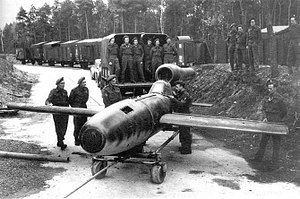| Fi 103R Reichenberg | |
|---|---|
 Fi 103R Reichenberg (without warhead) captured by British troops in 1945 | |
| General information | |
| Type | Manned missile |
| National origin | Nazi Germany |
| Manufacturer | Fieseler |
| Primary user | Luftwaffe |
| Number built | c. 175[1] |
| History | |
| Manufactured | October 1944 |
| First flight | September 1944 |
| Developed from | Fieseler Fi 103 (V-1 flying bomb) |
The Fieseler Fi 103R, code-named Reichenberg, was a German manned version of the V-1 flying bomb (more correctly known as the Fieseler Fi 103). It was developed towards the end of the Second World War and was intended to be used as a human-guided bomb in suicidal attacks against the advancing Allies.
The Fi 103R started development in 1944 at a time when Germany was anticipating a major naval landing by the Allies in western Europe. It was believed that a disposable aircraft armed with 900 kilograms (2,000 lb) of explosives would potentially inflict heavy damage on important targets such as enemy shipping. However, these attacks would have very likely involved the death of the pilot, who was expected to exit the aircraft and parachute away mere moments before the aircraft's impact. These pilots were reportedly to be volunteers and aware of the risk to their own lives. The "Leonidas Squadron", V. Gruppe of the Luftwaffe's Kampfgeschwader 200, was established in early 1944 to conduct these attacks.
Initially, the development of a manned Fi 103 had been considered but passed over for the rival Messerschmitt Me 328 project. However, this aircraft had fundamental difficulties with its pulsejet propulsion, which led to officials opting to switch focus to the Fi 103R's development. Pilots were trained using gliders, including specially-adapted ones capable of high-speed diving, it was intended for the R-III, a twin-seat powered model of the Fi 103R, to be used for the latter stages of training.[clarify] In September 1944, the maiden flight of the Fi 103R occurred, which resulted in a crash; a second aircraft flown on the next day also crashed. One month later, development was shelved at the direct order of Hitler, who had been encouraged by Albert Speer and Werner Baumbach not to pursue suicide attacks.
- ^ Bishop 2002, p. 320.